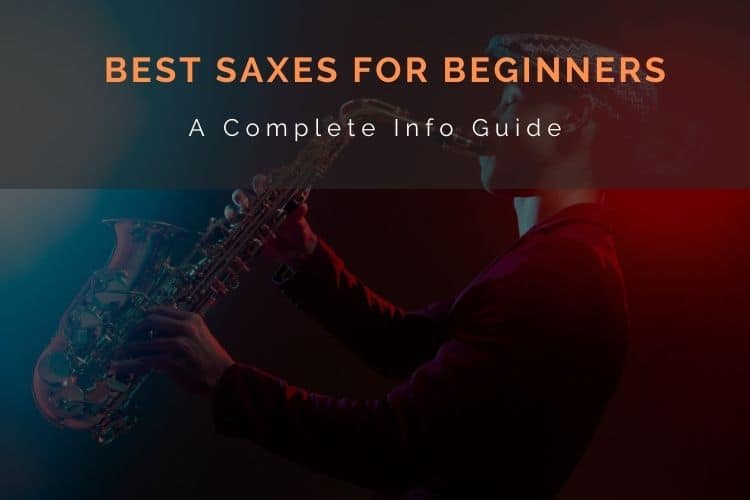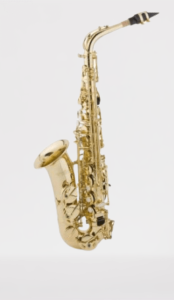So you or your child want to learn saxophone! Awesome! It’s an amazing instrument to play.
It’s a fundamental instrument in jazz and blues music, and also has a considerable presence in pop and classical music. Within woodwind instruments, it’s a very versatile instrument that works well in a number of different settings. It’s also super fun to play.
If you’ve looked at the prices of saxophones, you can quickly gather that they are not cheap instruments. Compared to many other instruments, saxophones tend to be more expensive. A professional model horn could run anywhere from $3,000 to $10,000 or more!
If you’re starting out, you really have no interest in instruments that cost this much. It’s too much of an investment for an instrument that you are still not sure if you will actually like, and if you are purchasing for a small child you may be concerned about how they will care for the instrument.
However, if you buy too cheap of an instrument, you may be deterred from playing sax because of the low quality of the instrument. The last thing you want is for the low quality of the saxophone to be the definitive challenge in learning the instrument.
In this article, I will be reviewing some of the most commonly reviewed models and offering suggestions for the best saxophone for beginners. I’m trying to offer you a no-nonsense basic review of many models without fancy technical terms as you might find around the web (spatula keys? Ribbed construction? F# key?).
I am reviewing and suggesting student alto saxophones as a beginner sax, although tenor sax is another possible option if you like to start on tenor.

Best Beginner Alto Saxophones
Yamaha YAS-280
Yamaha is generally the standard in student model alto saxes and a great saxophone for beginners.
Yamaha is known for its precision craftsmanship and great intonation. The construction is probably the best out of the saxes I will review, as Yamaha makes top-level professional saxes as well.
The YAS-280 is a sax that could take a moderate beating and will have great intonation and response.
It is the best option for a beginner, with the least amount of limitations from the horn. It does tend to be a little brighter in tone, but this won’t be a large consideration for the beginner. This saxophone would not need to be replaced for many years until the student is more advanced.
It’s a little bit pricier than some of the other budget options, but the resale value for Yamaha is very good, and you could get a large return on your investment if you want to resell it.
They generally run about $1300. You can check them out on Amazon.
- Pros: very good construction, intonation, and response
- Cons: a little more costly
Prelude AS711
Conn and Selmer are two of the biggest brands for saxophone, with many of the most prominent players using their horns.
They merged to form one company, and have offered the Prelude as their beginner model, in contrast to their professional models such as Selmer Paris. These are solid options for beginners.
They are slightly cheaper than the Yamaha, running at about $975. You can view it on Amazon.
- Pros: a good brand, and good construction
- Cons: a little bit more expensive if you aren’t ready to invest that amount
Jean Paul USA AS-400
Jean Paul USA saxes consistently get great reviews. A very good dark tone for a beginner alto saxophone, and amazing construction.
What’s more, they are only roughly $500 on Amazon. They are made in China but shop-checked in the USA.
View it on Amazon.
- Pros: great quality, great price
- Cons: none
Check it out being tested by a professional, in this case, Dave Pollack’s:
Etude EAS-100
These are great saxes to start with for the price, but you will not get the same type of precision that you would from something like a Yamaha.
The craftmanship quality is a bit lacking, but for such an affordable price, you can’t go wrong. Eventually, after a few years, it may need to be replaced by a more intermediate model.
Check it out at Woodwind and Brasswind.
- Pros: great price
- Cons: not the best quality
Here DeMarius Jackson reviews it:
Jean Baptiste 290AL
This is a saxophone often sold in Sam Ash music stores. Running at about $700.
These aren’t the best option in my opinion. The Sam Ash production factory has been known to change, and so it’s not easy to know the quality. It would be better to pick a different option or spend more for a better sax.
View at Sam Ash.

- Pros: Sam Ash is a large chain
- Cons: not reliable quality
Mendini By Cecilio
These saxes are very cheap and fairly popular, running about $300 on Amazon.
Generally a good option for the money, but the craftsmanship won’t be something that will stand the test of time. However, a great option for a beginner if you’re not sure if they will stick with it.
View it on Amazon.
- Pros: cheaper price, also easy to find on the internet
- Cons: lower quality
Allora AAS-250
These saxes are sold on a number of websites. They are pretty cheap and will work for a beginner.
I think for the money there are better options, however, this sax has been around for a while and there is plenty of information on its quality. Generally, the reviews are rather mediocre, but that may be fine for a beginning player.
View it on Woodwind and Brasswind.
- Pros: won’t break the bank
- Cons: not the best ratings in terms of quality
Eastar AS-Ⅱ
These saxes are only $300 on Amazon, and they are starting to get noticed because of their surprising quality of construction for the money. If you are on a budget, it’s impressive.
View it on Amazon.
- Pros: Amazing price and impressive construction!
- Cons: may be hard to fix, unsure of reliability over time, new brand
Eastar Vs Yamaha Sax
Here you can check out Saxologic’s entertaining review comparing Eastar with his professional Yamaha.
Better Sax
One of the problems is that finding an affordable beginner alto saxophone is very hard. Budget saxophones often have too many issues, and better quality saxophones are just simply too expensive for the beginner.
In order to combat this problem, Jay Metcalf at Better Sax set out to make an affordable student saxophone. I cannot speak personally for the saxophone as I haven’t tried it, but it is getting a great response from people.
View it at Better Sax.
- Pros: appears to be great beginner sax for the money
- Cons: relatively unknown brand
Here you can view the video:
Beginner/Intermediate Level Saxes
If you have a little more budget, these saxes are also an option and will set you for long-term use as well.
YAMAHA YAS-26
Another model for Yamaha. A classic beginner level sax that won’t let you down. It’s a slight step up from the YAS-280, but a considerable jump in price.
View it on Amazon.
- Pros: excellent beginner sax
- Cons: considerably more expensive instrument than some other saxes
You can see me performing with the Yamaha 62 series, in this promo video for my multi-instrumentalist show:
https://www.youtube.com/watch?v=B7-2__WP-O0&t=10s
Or here:
Jupiter JAS710GNA
These saxes are another option that is often associated with beginners. They have a quality and precision similar to Yamaha. However considering the price, they are rather disappointing for a beginner sax as one would expect more.
But, if you want an instrument that will last a long time without having to be replaced, this is a great option.
View it at Woodwind and Brasswind. View the step up model.
- Pros: great quality
- Cons: a bit expensive
Selmer USA 200-300 series
Selmer Paris has long been famous for saxophone manufacturing professional saxophones. From the famous Mark VI to the Super Action and Reference 54, it has a long history.
Selmer USA is now a different company entirely, but it does put out some good saxophones, especially for the beginner/intermediate player.
The 200 and 300 series run about $2400-$2500 and are designed for the beginner.
View the 200 series here, and the 300 series here.
- Pros: great quality and brand
- Cons: not cheap
Mauriat PMSA-57GC Intermediate
Mauriat is fast becoming a top model among professionals. Made in Taiwan, the quality is impressive, so much that professionals are selling their expensive horns and buying P. Mauriat.
Not as good as Yamaha in my opinion, but a great horn. This is their intermediate model that would also work well for a beginner, especially because of the price.
View it at Woodwind and Brasswind.
- Pros: cheaper than some of the other brands, great build and quality
- Cons: none
Giardinelli GAS-300
This sax is fantastically constructed for a student sax and is a little bit cheaper than some of the other saxes in this price range. Definitely worth checking out as an option.
View it at Woodwind and Brasswind.
- Pros: good construction, a little bit more affordable
- Cons: not as well-known as some other brands
What to Consider When Looking for Beginner Saxophones
There are a couple of things and options to consider when looking at saxes for student level players:
Buying Used Saxophones
If you are starting out and know nothing about saxophones, it might be a good idea to avoid used horns, unless they are in very good condition.
If you can’t tell the difference between a good sax and a not so good sax, better not to go that route. However, if you want to bite the bullet and take the risk, the reality is that you can often get a higher quality sax for less money.
Check our article on how to buy a used sax:
Saxophone Brands
A quick search will probably bring many brands for a sax. It’s important to be an informed buyer. The brand name is important for saxophones, as well as where it is made to some degree.
No name brands with no information are often something to stay away from. The improvement of manufacturing in China has changed the production of saxophones somewhat. Some of the brands or models that were in production 20 years ago are no longer being manufactured, while newer Chinese and Taiwanese models are starting to become mainstays. Some cheap saxophones play surprisingly well.
However, they come with some cons:
- Very difficult to tell the quality. Most cheap brands only last a few years. And the range of quality is quite vast.
- Repairing one is an issue. These brands are not familiar, so repairing them may be more difficult than something like a Yamaha. Also, the cost of the repair may be the same amount you paid for the saxophone in the first place.
Renting to Own
Another option is renting to own a sax. However, keep in mind that renting may eventually cost you more than if you were to go out and buy the sax outright. Here in this article we try to outline the best saxophones for beginners and give a thorough review of many of the popular brands found.
Renting to own, is among the different rental options that exist for music instruments. Check what to consider for each rental solution in this article:
Construction
Saxophones are generally of a yellow brass body. The general construction is similar for every saxophone, however, the quality of the equipment, as well as the placement of the tone holes, are important considerations that can affect the sound quality.
The saxophone is notoriously out of tune due to its conical bore, so the placement of the tone holes is very important.
Pads

The quality of the pads is also very important. If the pads will not seal because they are low quality or are not taken care of well, this will be a very important consideration.
An important note on taking care of pads: it’s important to get a saxophone swab and clean it. You want to clean the body, as well as the neck. For a better explanation, the body is the big part and the neck is the small part.
There is something called a Padsaver that was very popular for a while in previous years and is still being used. It’s a big fluffy rod that goes inside the sax. While these seemed like a good idea at first, they are actually not good for the pads because they don’t allow the pads to dry properly.
Swabs
Instead, make sure you get a cleaning SWAB to clean it. There are many different kinds. It’s among one of the most important accessories for saxophones.
This can be hard for a young child to maintain discipline, but this will extend the life of the sax. Repairs can be expensive, and if you purchased a cheap saxophone, the repair might end up costing almost as much as the sax.
As well as a swab, there are some other considerations to keep in mind.
Reeds
The sax will probably come with reeds. You will most likely want to get different reeds as the ones that come with the sax will probably be low quality.
Reeds wear out. You can’t play on one reed forever. Get a reed guard to help keep the reeds flat.
Rico is a standard beginner brand. If you can afford better, La Voz, Hemke, Rico Royal, and Vandoren are a bit better quality.
Our guide to saxophone reeds helps beginners on what to consider before opting for sax reeds:
Mouthpiece
The standard for a student mouthpiece is the Yamaha 4C.
It’s excellent because it is very easy to play. You won’t get an amazing tone like you would from a more expensive mouthpiece, but for the feasibility of playing it is hands down the best you can get.
The sax you purchase will definitely come with a mouthpiece. The quality of that mouthpiece is very unreliable.
Do yourself a favor and pick up a Yamaha 4C. They are pretty cheap.
Read the following article on what mouthpieces options do you have for alto and tenor saxophones:
Get to Know the Types of Saxophones
Alto Saxophones
Most sax beginners start on the alto sax. It’s pitched in Eb.
In terms of playability for a beginner, it is the most feasible. It doesn’t take that much air in comparison to tenor and baritone saxes, and the intonation is much easier than the soprano sax.
It’s also often the cheapest, and there is plenty of band music written for the alto sax.
Also, many famous jazz saxophonists have played the alto sax such as Charlie Parker, as well as a considerable amount of alto sax in pop music. It is also arguably the most written for within classical saxophone repertoire.
Tenor Saxophones
Another secondary option is the tenor sax. It’s pitched in Bb.
The tenor sax is possibly the most chosen among professional players. Many of the famous jazz saxophonists played tenor such as John Coltrane, and it is also the classic dirty saxophone sound heard in a lot of rock and roll.
The alto will be an easier start in terms of playability and feasibility of finding music, but if your heart is set on the sultry sound of the tenor sax, it can be an option as well.
There are two other saxophones in common usage that I will mention here, but that are not suitable for beginner players.
Soprano Saxophones
The soprano is higher pitched and resembles a clarinet in appearance. It’s pitched in Bb.
It’s used in jazz, pop, and classical. It’s also very popular in Smooth Jazz with artists such as Kenny G. This is not an easy instrument to start on as it is very hard to keep in tune.
Also, there is not a lot of common music written for soprano sax, as it’s often considered a “double” for an alto or tenor player. It’s a great instrument if you want to learn it later on, but I don’t recommend starting on this instrument.
Baritone Saxophones
The baritone sax is the largest of the saxes and is pitched in Eb.
It’s not often treated as a solo instrument, but it has been used as a solo instrument in a number of cases, such as Harry Carney. You can hear it often in music that uses horn sections such as big band jazz, R&B, and salsa music.
The baritone sax has a great sound and it’s one of my favorites. However, I don’t recommend starting on this instrument either.
It takes an incredible amount of air, which is not conducive to beginner players. Also, for a child, the sax might be as big as them! It’s much too cumbersome for a small child to start on.
My Vote for the Best Beginner Saxophones
In summary and after reviewing different beginner saxophone models options, my top 3 for the best student alto saxophone are:
Yamaha YAS-280
This is the best saxophone for beginners in terms of all the things considered.
It has been the standard in beginner saxophones for a long time and provides the precision and playability that will benefit the player for years to come.
Jean Paul AS-400
A close second to Yamaha, this sax is unbelievable for the money. If the Yamaha is too expensive, get the Jean Paul. At $500, it’s totally worth it.
Best Budget sax: Eastar
This sax is getting noticed for its precision craftsmanship for the money. If you’re looking for a budget option, this might be the one to choose.
Final Considerations
If you have the money to spend on any of the higher priced models, you won’t be disappointed. However, this requires an amount of investment that the beginner player may not be able to provide.
It’s important to keep in mind that this article is about the best saxophones for BEGINNERS. I’ve tried to keep the price in consideration because of the high cost of saxophones and find the best balance between price and quality.
However, if you are looking for a professional horn, these saxophones will be limiting for you. You will need to be looking to spend more.
Yamaha, Yanagisawa, Selmer Paris, and Keilwerth are the general professional brands for someone looking for a professional saxophone. However, you may find a great horn from companies such as P. Mauriat, Cannonball, or Selmer USA.
FAQs
What Type of Saxophone Should a Beginner Buy?
A beginner should buy an alto saxophone. They are often the cheapest and in terms of playability are the most feasible for a beginner. The alto sax doesn’t take that much air in comparison to tenor and baritone saxes.
Apart from the alto, another secondary option is the tenor sax. It would be a bit more difficult in terms of playability and feasibility of finding music, but if your heart is set on the sultry sound of the tenor sax, it can be an option as well.
How Much to Spend on Your First Alto Saxophone?
Depending on the quality you are looking for, you can spend between $300 to $1,300. Such a price range would set you with a proper alto sax for starting.
We’ve detailed high-quality alto saxes that start at about $500 (like the Jean Paul AS-400), but there are also others with a bit of lower quality starting at $300 (for example the Easter).
What Are the Best Alto Saxophones Brands?
The following brands can be considered the best for beginner alto saxes: Yamaha, Jean Paul, Conn and Selmer, and Jupiter.
For professional-level alto saxophones, Yamaha, Yanagisawa, Selmer Paris, Keilwerth, P. Mauriat, Cannonball, or Selmer USA offer higher quality instruments.

Author: Cooper White
- Cooper is a Multi-Instrumentalist, with vast knowledge and experience performing with Sax, Flute, Clarinet, Keyboard, and Blues Harmonica.
- With a Bachelor’s Degree from the Berklee College of Music in Boston and studies in Classical Performance at the Lionel Hampton School of Music, he has also more than 10 years of performing professionally, whether while road touring in the U.S. or playing on different cruise ships.
- He is also an entertainer with his shows, as well as a producer of his music and others. Whenever he is not performing, he teaches individual online classes. He mostly plays Jazz, Classical and Popular music.